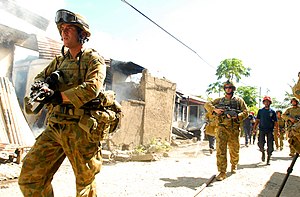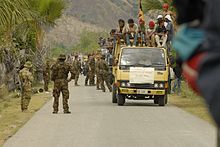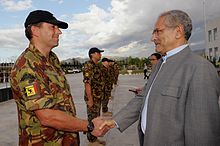
Australia joined a U.S.-led coalition in the Iraq War. Declassified documents reveal that the decision to go to war was taken primarily with a view to enhancing its alliance with the United States.

The Australian contribution to the war in Afghanistan has been known as Operation Slipper (2001–2014) and Operation Highroad (2015-2021).
The Meritorious Unit Citation is a collective group decoration awarded to members of Australian military units. It recognises sustained outstanding service in warlike operations. The Meritorious Unit Citation was created in 1991, along with the Unit Citation for Gallantry.

6th Battalion, Royal Australian Regiment is a mechanised infantry battalion of the Australian Army. It was originally raised in Brisbane, Queensland, on 6 June 1965 and has since then served in a number of overseas deployments and conflicts including South Vietnam, East Timor, Iraq and Afghanistan. During the Vietnam War, the battalion earned a US Presidential Unit Citation from the United States when members from 'D' Company participated in the Battle of Long Tan on 18–19 August 1966. The battalion is currently based at Gallipoli Barracks in Brisbane and forms part of the 7th Brigade.

The 3rd Brigade is a combined arms brigade of the Australian Army, principally made up of the 1st and 3rd Battalions of the Royal Australian Regiment. Initially raised in 1903 as part of the post-Federation Australian Army, it was removed from the order of battle in 1906 following the restructure of the field force. It was re-formed in 1914 for service during World War I, taking part in the fighting at Gallipoli and on the Western Front in Europe. During World War II the brigade was used in a defensive role before it was disbanded in 1944. It was re-raised in 1967 for service during the Vietnam War and later went on to provide the nucleus of the deployment to East Timor during the Australian-led intervention in 1999. The brigade is currently based at Lavarack Barracks in Townsville, Queensland.

The International Force East Timor (INTERFET) was a multinational non-United Nations peacemaking task force, organised and led by Australia in accordance with United Nations resolutions to address the humanitarian and security crisis that took place in East Timor from 1999–2000 until the arrival of UN peacekeepers. INTERFET was commanded by an Australian military officer, Major General Peter Cosgrove.

The 3rd Battalion, Royal Australian Regiment is a mechanised infantry battalion of the Australian Army, based in Kapyong Lines, Townsville as part of the 3rd Brigade. 3 RAR traces its lineage to 1945 and has seen operational service in Japan, Korea, Malaya, Borneo, South Vietnam, Rifle Company Butterworth, East Timor, the Solomon Islands, Afghanistan and Iraq.

The 5th Aviation Regiment is an Australian Army aviation unit. Formed in 1987 after the Army took over responsibility for operating helicopters from the Royal Australian Air Force, the regiment is based at RAAF Base Townsville, in Queensland. It currently forms part of the 16th (Aviation) Brigade and it operates the majority of the Army's transport helicopters. Throughout its existence, the regiment has been deployed overseas numerous times, supporting both peacekeeping and warlike operations. Since its formation elements of the regiment have made operational deployments to Cambodia, Papua New Guinea, East Timor, Iraq, Indonesia and Pakistan.

HMAS Tobruk was a Landing Ship Heavy (LSH) of the Royal Australian Navy (RAN), based on the design of the Round Table-class of the British Royal Fleet Auxiliary. Planning for the ship began in the 1970s to provide the Australian Army with a permanent sealift capability. She was laid down by Carrington Slipways in 1979, launched in 1980, and commissioned in 1981. She was a multi-purpose, roll-on/roll-off heavy lift ship capable of transporting soldiers, APCs, and tanks, and delivering them to shore via landing craft or directly by beaching.

1st Battalion, Royal Australian Regiment is a regular motorised infantry battalion of the Australian Army. 1 RAR was first formed as the 65th Australian Infantry Battalion of the 34th Brigade (Australia) on Balikpapan in 1945 and since then has been deployed on active service during the Korean War, the Malayan Emergency, the Vietnam War, Unified Task Force in Somalia, East Timor, Iraq War and Afghanistan. Additionally, the battalion has deployed on peacekeeping and other operations to a number of countries including Japan, Rifle Company Butterworth, Timor Leste, Solomon Islands, Tonga and the Philippines. 1 RAR remains one of the Australian Army's most readily deployed units sending individuals and detachments to domestic, regional and other enduring operations. The battalion is currently based in Coral Lines at Lavarack Barracks, Townsville, Queensland, where it forms part of the 3rd Brigade.
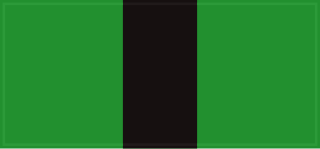
The 2nd Battalion, Royal Australian Regiment is an amphibious light infantry battalion of the Australian Army part of the 1st Division Amphibious Task Group based at Lavarack Barracks in Townsville.

Australia was a member of the international coalition which contributed military forces to the 1991 Gulf War, also known as Operation Desert Storm. More than 1,800 Australian Defence Force (ADF) personnel were deployed to the Persian Gulf from August 1990 to September 1991, while contingents from the Royal Australian Navy circulated through the region in support of the sanctions against Iraq until November 2001. In August 1990, two frigates HMAS Adelaide and HMAS Darwin and the replenishment ship HMAS Success left for the Persian Gulf. HMAS Success had no air defences, so the Army 16th Air Defence Regiment was embarked. On 3 December 1990, HMAS Brisbane and HMAS Sydney (IV) relieved HMAS Adelaide and HMAS Darwin. On 26 January 1991, HMAS Westralia replaced HMAS Success. A Navy clearance diving team was also deployed for explosive ordnance disposal and demolition tasks. Australian ships were in danger of sea mines and possible air attacks. In a number of recorded incidents, HMAS Brisbane encountered free floating mines, on one occasion narrowly avoiding a collision. Both HMA Ships Brisbane and Sydney encountered significant air threat warnings from Iran and Iraq throughout the initial period of the commencement of the Desert Storm Campaign. The detection of land based Silkworm anti-ship missiles from Iran throughout the campaign also added to the challenges for both crews as well as the multi-national Naval Forces.
The British Commonwealth Far East Strategic Reserve was a joint military force of the British, Australian, and New Zealand armed forces. Created in the 1950s and based in Malaya, the FESR was conceived as a forward defence point for Australia and New Zealand, while protecting Commonwealth interests in the Southeast Asian region from both internal and external communist threats. The FESR was made up of an infantry brigade and an aircraft carrier group, supported by squadrons of aircraft.
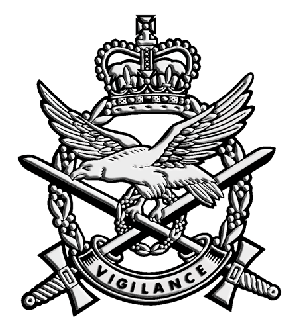
Australian Army Aviation (AAAvn) is a corps of the Australian Army. It was formed on 1 July 1968. The motto of the Australian Army Aviation corps is Vigilance.
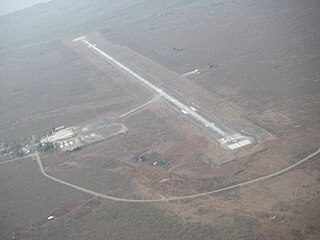
Baucau Airport, formerly Cakung Airport, is an unattended and mostly unused airport near Baucau, East Timor. It is the largest airport in East Timor, and has a much longer runway than Dili's Presidente Nicolau Lobato International Airport, long enough to handle large commercial airliners.

The 11th Brigade is an Australian Army brigade which currently comprises most Australian Army Reserve units located in Queensland. The brigade was first formed in early 1912 following the introduction of the compulsory training scheme. Later, as part of the 3rd Division and saw action during World War I on the Western Front as part of the First Australian Imperial Force. In the interwar years, the brigade was re-raised with its headquarters in Brisbane.
The 173rd Aviation Squadron is an Australian Army helicopter training squadron equipped with MRH 90 Taipan helicopters and provides support to the Special Operations Command. The squadron is based at Luscombe Airfield, Holsworthy Barracks, Sydney and forms part of the 6th Aviation Regiment. The squadron may have been renamed as it does not appear in an Army December 2020 Order of battle.

The Battle of Same was fought in the village of Same in Timor Leste, 50 kilometres (31 mi) south of the capital Dili, between Australian Special Forces and Petitioner rebels under the command of Alfredo Reinado. The operation occurred under the auspices of Operation Astute, being the deployment of Australian forces in the wake of 2006 East Timorese crisis, and resulted in the Australians successfully securing the target compound and defeating the small rebel force, before the assault was called off by the Timor Leste government. Reinado and nine other rebels subsequently evaded the Australian cordon, however, and made good their escape into the mountains.

The Indonesia–Malaysia confrontation was fought from 1962 to 1966 between the British Commonwealth and Indonesia. Indonesia, under President Sukarno, sought to prevent the creation of the new Federation of Malaysia that emerged in 1963, whilst the British Commonwealth sought to safeguard the security of the new state. The war remained a limited one however, and was fought primarily on the island of Borneo, although a number of Indonesian seaborne and airborne incursions into the Malay Peninsula did occur. As part of Australia's continuing military commitment to the security of Malaysia, Australian army, naval and air force units were based there with the Far East Strategic Reserve, mainly in the 28th Commonwealth Infantry Brigade Group.

The logistical support of the multinational International Force East Timor (INTERFET) peacekeeping mission in 1999 and 2000 involved, at its peak, 11,693 personnel from 23 countries. Of these 5,697 were from Australia, making it the largest deployment of Australian forces overseas since the Vietnam War. INTERFET was unusual in that it was led by Australia, casting the country in a wholly unfamiliar role. The logistics and support areas of the Australian Defence Force (ADF) had been subject to deep cuts in the 1990s. The ADF had not anticipated being committed to such a large peacekeeping mission, and was unprepared to support an Australian force projection of this size, much less act as lead nation of an international coalition.
